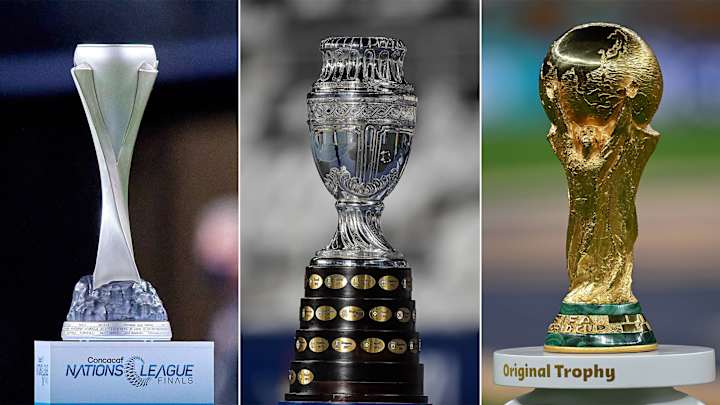Concacaf Revamps Nations League, Unveils Copa America and World Cup Qualifying

The U.S. will have to win just one of two potential home-and-away series against Concacaf opposition to qualify for the 2024 Copa América, the regional governing body revealed Tuesday as it unveiled its ’23–25 senior men’s competition structure.
Next year’s Copa América, which will be staged in the U.S., will include six Concacaf qualifiers alongside the 10 South American nations that traditionally contest the prestigious tournament. Those six Concacaf teams will be furnished by a revamped 2023–24 Nations League, which will be streamlined for the region’s top-ranked countries. The Americans will get their first crack at qualifying for the Copa this November.
Concacaf also revealed the qualifying format for the expanded, 48-team 2026 World Cup, which will be played across the U.S., Mexico and Canada. The three host nations will be exempt, leaving the region’s remaining 32 eligible members to vie for three automatic berths and then two spots in an intercontinental playoff. Concacaf’s World Cup qualifiers won’t kick off until March ’24.
Here’s a breakdown of how the restructured Nations League and qualifying for both the 2024 Copa América and ’26 World Cup qualifying will work:
Nations League
It begins with the Nations League, the three-tiered, secondary competition launched in 2018 and designed primarily to provide more matches for the region’s smaller members. Its main competitive purpose for the top end of the confederation has been qualifying for the Gold Cup, Concacaf’s biennial championship.
Although the Nations League’s first “final four” in June 2021 was successful (and won by the U.S.), the bigger teams weren’t thrilled by a schedule clogged with repetitive or redundant games against weaker sides. The new Nations League format addresses that issue, reducing by two the number of matches that the likes of Mexico and U.S. might have to play.
The ongoing 2022–23 Nations League tournament will conclude with the remaining group-stage games next month—the U.S. faces El Salvador and Grenada and needs at least one point to guarantee a ’23 Gold Cup spot—and then the final four in June. The new Nations League format will impact subsequent editions of the tournament.
League A will expand from 12 teams to 16, so there will be no relegation this year. The four 2022–23 League B group winners will fill out the ’23–24 field. In ’23–24, the 12 lowest-ranked sides (Concacaf issues its own national team ranking) will be split into two groups of six teams. They’ll each play four games this September and October (it won’t be a full round-robin), after which the top two finishers in both groups will advance to a new home-and-away quarterfinal round. There, Concacaf’s four top-ranked teams will be waiting, having had the September and October windows free to pursue their own competitive interests. November’s quarterfinal winners will contest the ’23–24 Nations League final four in March ’24.
Concacaf will use its March 2023 ranking to seed the ’23–24 League A groups and quarterfinal byes. In the most recent ranking, released Jan. 1, Mexico was first, followed by U.S., Costa Rica, Canada and Panama. It’s unclear whether the March Nations League games, the last to impact that critical ranking, carry enough weight to alter the top four.
From 2023 to ’24, Nations League B will remain at 16 teams, and League C will fall from 13 sides to nine.
2024 Copa América and ’25 Gold Cup qualifying
The 2023–24 Nations League is especially important because it will determine the six Concacaf teams that play in the ’24 Copa América. The four countries that win this November’s home-and-away quarterfinal series will qualify. That means, barring an unexpected change in the ranking, that Mexico, U.S., Costa Rica and Canada are just 180 minutes from guaranteeing their Copa América place. Each quarterfinal will pit a top-four seed against a League A qualifier.
The four Nations League quarterfinal losers will then get a second chance at Copa América qualifying in March 2024. They’ll be paired in two single-game qualifiers at a neutral site. Those two winners also will qualify for the Copa.
The 2024–25 Nations League, the second played under the new format, will furnish teams for the ’25 Gold Cup. There’s been talk about expanding that Gold Cup, perhaps significantly, to include multiple guest teams as a preparatory event for the ’26 World Cup. Concacaf said Tuesday that details regarding ’25 Gold Cup qualifying “will be announced in due course.”
2026 World Cup qualifying
Concacaf, which includes 35 FIFA members, could wind up having eight teams at the North American World Cup. The three hosts are already in. Three more spots are guaranteed, then an additional one or two are possible via a playoff.
In March 2024, the four lowest-ranked Concacaf sides in FIFA’s November ’23 ranking will be seeded into a pair of home-and-away series. The two survivors will fill out a 30-team second round.
That second round will feature six groups of five teams. Each nation will play the others in its group once—two home and two away—across two-game windows in June 2024 and June ’25. The group winners and runners-up will advance to the 12-team third round.
There, teams will be drawn into three groups of four and then play a six-game, home-and-away round robin in the fall of 2025. The three group winners will qualify for the World Cup. The two best runners-up will move on to FIFA’s last-chance intercontinental playoff, which will feature six sides (two from Concacaf and one each from South America, Africa, Asia and Oceania) and determine the last two World Cup tickets. The intercontinental playoff will likely be played at a single location in the U.S., Mexico or Canada.

A lifelong soccer player, coach and fan, Brian Straus joined SI in 2013 after covering the sport for The Washington Post, AOL and Sporting News.